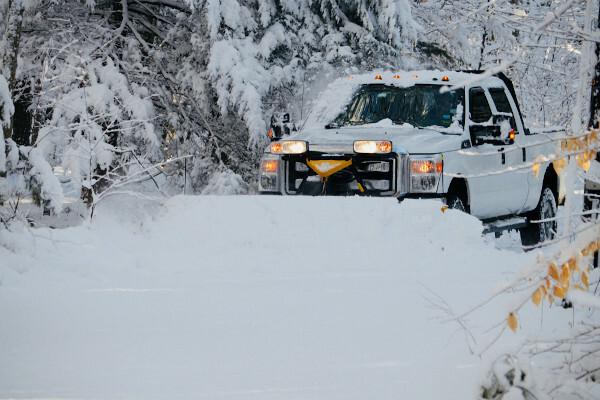THE snow formation is associated with the meteorological phenomena that cause the change of physical state from water and its solidification process. Snow can be found in several types in nature — flake, hail, snow grain, among others. Snow, in general, is part of the daily life of many people and cultures in the north of the planet where there is a fixed population.
Populations that develop in areas where snow occurs are subject to some damage, such as landslides, avalanches and accidents related to these activities. In Brazil, in some cases, we have the occurrence of snow, something rare for a country of tropical weather, however with some records over the years.
Read too: What is the difference between weather and climate?
snow formation
Snow is a meteorological phenomenon caused by low temperatures or abrupt drop in the temperature of the place. This phenomenon occurs more frequently in countries that present polar climates, cold or seasoned.
Snow can occur in tropical climate regions or similar weather very rarely, and for that,
other climatic or meteorological phenomena need to happen or be associated with the fact, such as the movement of air masses or marine currents from the coldest regions of the planet (such as the Earth's poles, regions of the Arctic Circle and Antarctic Circle).
When coming from these regions, oceanic air masses or winds bring with them low temperatures and cold, and when they enter contact with hot regions, promote the change of temperature, freezing the water vapor, which can form snow in more places. remotes.
Snow forms on the cloud through the solidification of water vapor when there is a drop in temperature, forming ice crystals. The water vapor freezes, forming ice crystals that fall in the form of precipitation (rain) of snow.
types of snow
Snow can present itself in a number of ways in nature, according to the American Meteorological Society. These types are very difficult to differentiate in the wild, although they they present themselves with different shapes, densities and structures from each other. There are seven in total, check it out:
- Snowflake: it is the best known form of snow in the world, of common occurrence. It is a flake-shaped ice crystal, hexagonal in shape and similar to a small star.
- Snow grain: called granular snow, it is the precipitation of snow with a very small, opaque grain of ice, corresponding to the solid form of drizzle. It may present an irregular spherical shape or a rarer, conical shape. When coming into contact with the surface, it can cause noise, such as on roofs or on the floor.
- Graupel: it is the heaviest ice particle, known as an ice pellet. It is usually confused with fine hail, however, to be fine hail, the diameter must be greater than 5 mm.
- Hail: is the solid ice stone, with a size equal to or greater than 5 mm. O hail it can appear in nature in larger sizes, and in these cases it causes damage to the surface it touches when dropped.
- Frozen rain: it is rain in a liquid form that freezes when it comes in contact with the surface. This phenomenon only occurs when there is precipitation and temperatures close to the soil surface are very low, below zero.
- Snow water: it consists of partially molten snow — traces of water droplets with snow inside. It is usually transparent, not white as snow, it resembles a drop of water in the process of freezing.
- Icicle: it is the freezing of particles or droplets of water in suspension when there is a fog. Freezing occurs when water droplets come into contact with the surface. At this time, temperatures are usually between -2 °C and -8 °C.
See too: What are the differences between snow, frost and hail?
Snow in culture and everyday life
snow is part of culture and from the lives of several people. There are many countries and social groups that have adapted to this way of life, some of these countries are:
- Russia
- Greenland
- Canada
- USA
- Sweden
- Finland
- Norway
- Ireland
These countries have adapted, over time, to this climate reality, creating their own cultures.
An example of these cultures is sports. There are several modalities practiced in places where there is snow, like:
- snow ski
- ski jump
- snowboard
- figure skating
- speed skating
- ice Hockey
- skeleton
- curling
- alpine skiing
These sports are present both in the daily life of the Nordic countries and in the biggest sporting event dedicated to them, known as Winter Olympics, created in 1924.

Another cultural aspect is the attractions of cities that gain worldwide prominence and popularity for their link with the snow. In this sense, the following stand out:
- New York, United States
- Toronto, Canada
- Berlin, Germany
- Prague, Czech Republic
- Zurich, Switzerland
These cultures have economic activities linked to tourism and receive many tourists throughout the year, especially, of course, during periods when there is snow.
Also access: Cultural historical heritage - cultural production of a given society

consequences of snow
Some consequences can occur in relation to snow, usually in countries or locations that are not adapted or prepared for this phenomenon. Some can be more severe, such as the deaths of the human population, fauna or flora; others can be lighter, such as mobility problems.
You can initially consider the difficulty in maintaining animal and plant life in places with snow occurrence. Few are the species adaptable to these environments, in the case of flora, temperate and coniferous forests are cited as plant formations capable of adapting to low temperatures. In the case of fauna, wolves, rabbits, bears, squirrels and moose are among the species that live in these most inhospitable environments on Earth.
When we talk about human beings, the impacts are even greater, as the difficulties range from housing, food production, energy production, transportation, and people's transportation. When there are snowstorms, the traffic becomes impossible; the houses may not support the weight of the snow, even collapsing; there may be fuel freezing, which causes houses not to heat; and hypothermia it can happen to people and help may not arrive in time.
In more extreme cases, it is common to see people dying from avalanches, snow traffic accidents and hypothermia.

snow in Brazil
It is not common for snow to occur in Brazil for being a country with a predominantly tropical climate and high temperatures throughout the year. However, in isolated cases, the occurrence of this phenomenon in the country can be observed. It is about understanding the climate dynamics and the movement of air masses.
Brazil, in summer, is directly influenced by an air mass known as the Atlantic Polar Mass (MPA). This mass forms near Antarctica, in the Atlantic Ocean, and goes towards the south of South America, thus affecting the south of Brazil. When coming into contact with these regions, it promotes a drop in temperature, which can cause the phenomenon of snow by freezing water in the atmosphere.
The Brazilian regions that may be affected by these conditions are the regiions South and Southeast, as they suffer direct action from air masses, and some regions that have high altitudes, such as mountains and hills. The occurrence of the phenomenon of snow formation was observed in 1975, 1985, 1994, 2013 and, more recently, in 2020, in the South and Southeast. This phenomenon tends to occur at other times, as long as there is movement of air masses in Brazil or the influence of another climatic factor.
By Gustavo Henrique Mendonça
Geography teacher

